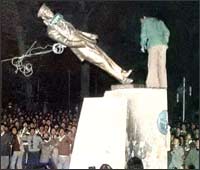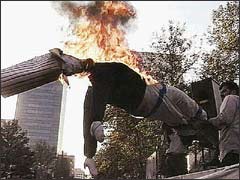Listen to the documentary:
Part
1
Part
2
Part
3
The First Shots of a Revolution
 |
| Protesters topple statue of Shah. |
The story begins in 1979 in Iran. In that year, the U.S.-backed
Shah and his family fled the country, and exiled cleric Ayatollah
Ruhollah Khomeini returned to establish the Islamic Republic
of Iran. Revolutionaries stormed the American Embassy in Tehran
and took staff as hostages. After 444 days in captivity, the
hostages were finally released in January 1980, after
the terms that had been laid out were met.
More than two decades later people in Iran are back on the
streets, albeit for different reasons.
It is a pleasant Wednesday night in Tehran, capital of the
Islamic Republic of Iran. A war may be raging next door in Afghanistan,
but here in Mohseni Square, the kids are demonstrating about
something more important. Iran's national soccer team has just
defeated the United Arab Emirates to keep alive its hope of
playing in the World Cup.
Up Mirdamad Boulevard the crowd spreads. The middle of the
tree-lined boulevard has been taken over by kids in their teens
and early twenties. Boys and girls... dancing.
 |
| Hostage blindfolded outside American
Embassy in Tehran, 1979 |
While this may seem normal, in a country where dancing in public
is forbidden, it is a small act of defiance. Not that the boys
and girls are dancing with each other. Things haven't gone that
far, but here in Iran the authorities are taking notice. This
is the third soccer demonstration in as many weeks. Ten years
ago, five years ago, maybe even last year, this scene would
have been impossible to imagine. Now, signs of change are all
over Tehran.
A half-hour or so before kickoff, in an Internet cafe in the
fashionable Farmanieh section of town a TV broadcasts evening
prayers. In another corner, a young woman yaks away to a friend
in Paris via the net.
The cafe is a hangout for the neighborhood's affluent twenty
and thirty year olds like Mehezda, 34, who works in marketing
for BBD&O. He says the weekly soccer demonstrations aren't
necessarily political, that they are a product of youthful energy,
not desire for another revolution.
Football is as good a place as any to sublimate youthful life
force in a society where 65 percent of the population is under
25, dancing in public is forbidden, drinking is illegal, and
women must cover their head in public and wear clothing that
obscures their shape.
The demonstration at Mohseni Square had been underway for about
half an hour. To call it a riot would be an exaggeration. Any
college police force in America would be grateful for such a
light-hearted celebration after a big win by the football team.
Tehran's uniformed police were laughing along with the crowd,
but the Basiji weren't.
The Basiji are a kind of plainclothes militia, loyal to Iran's
Supreme Leader, Ayatollah Ali Khameni. Two years ago, the Basiji
brutally put down demonstrations for greater personal freedom
at Tehran University.
As the soccer revelry grew louder the militiamen grew angrier.
They set off tear gas and chased the dancers up Mirdamad Boulevard,
flailing away with sticks and truncheons. The Basiji come from
a different part of the city.
Tehran's topography perfectly reflects the capital's social
order. In this city of 12 million, the wealthy live above the
smog and gridlock along the flanks of the Alborz mountain range.
As you move down the slope, you descend through Iran's social
classes. At the bottom, in the hot flatlands south of the city
center, you find the working poor and the recent arrivals from
the countryside. These are the late Ayatollah Khomeni's people.
This is where the Basiji come from.
There, at the southern edge of the city is where you will find
the tomb of the founding father of the Islamic Revolution. It
has become a modern shrine for his supporters.
 |
| Protesters burn Uncle Sam in effigy,
in Anti-American demonstration. (AP) |
Next door to the shrine is the Behesht e Zahra cemetery, the
Martyr's Cemetery. In the Islamic Republic, soldiers don't simply
die in combat, they are "martyred." Thousands of the
dead here are among the more than half a million Iranians killed
in the Iran-Iraq war. Many of those buried here were also called
Basiji, special volunteers. They were the men who made up the
suicide squadrons sent by the Ayatollahs against the army of
Saddam Hussein.
From top to bottom, Tehran, now more than twenty years after
the Islamic Revolution, has the feeling of the Soviet Union
during the time of glasnost. Up the hill, reform seems an unstoppable
force, down the hill among the families of the martyrs, allegiance
to the revolution and its puritanical Islamism is strong. Blood
sacrifice is the ultimate loyalty oath.
The tug of war between reformers and conservatives, between
the secular and the religious in Iran predates the revolution.
It predates the Shah, in fact it has been part of Iranian society
for at least 150 years.
Youssef Alijabadeh, of the Iranian Academy of Philosophy says
democratic society in the Western world is product of the Enlightenment.
He says in the West, the movement took 200 years to mature and
succeed, but "In the developing world, when the question
of setting up democratic structure arises, this process is completely
overlooked."
Continued: Struggle for the Direction
of a Nation



